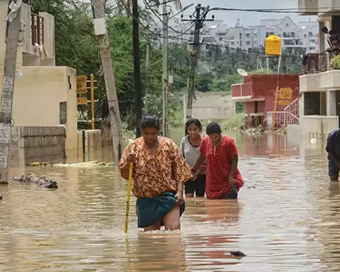 PM Modi visit USA
PM Modi visit USA Only the mirror in my washroom and phone gallery see the crazy me : Sara Khan
Only the mirror in my washroom and phone gallery see the crazy me : Sara Khan Karnataka rain fury: Photos of flooded streets, uprooted trees
Karnataka rain fury: Photos of flooded streets, uprooted trees Cannes 2022: Deepika Padukone stuns at the French Riviera in Sabyasachi outfit
Cannes 2022: Deepika Padukone stuns at the French Riviera in Sabyasachi outfit Ranbir Kapoor And Alia Bhatt's Wedding Pics - Sealed With A Kiss
Ranbir Kapoor And Alia Bhatt's Wedding Pics - Sealed With A Kiss Oscars 2022: Every Academy Award Winner
Oscars 2022: Every Academy Award Winner Shane Warne (1969-2022): Australian cricket legend's life in pictures
Shane Warne (1969-2022): Australian cricket legend's life in pictures Photos: What Russia's invasion of Ukraine looks like on the ground
Photos: What Russia's invasion of Ukraine looks like on the ground Lata Mangeshkar (1929-2022): A pictorial tribute to the 'Nightingale of India'
Lata Mangeshkar (1929-2022): A pictorial tribute to the 'Nightingale of India' PM Modi unveils 216-feet tall Statue of Equality in Hyderabad (PHOTOS)
PM Modi unveils 216-feet tall Statue of Equality in Hyderabad (PHOTOS)The Badminton Association of India (BAI) has announced a 14-member-strong India squad for
- Men’s Sr Hockey Nationals to be played in division-based format from April 4
- Mensik denies Djokovic 100th title in Miami final
- KIPG: Son of a vegetable vendor, Bihar’s Jhandu Kumar eyes Worlds, 2028 Paralympics
- Hardik Singh credits hard work and team unity for receiving HI Midfielder of the Year award
- Djokovic, Alcaraz land in same half of Miami draw
Third of UP voters cite power cuts as top election issue Last Updated : 06 Feb 2017 03:07:33 PM IST 
(File photo)
Almost a third of voters polled said power cuts were the biggest problem in Uttar Pradesh, according to a new survey conducted by by FourthLion Technologies, a data analytics and public opinion polling firm, for IndiaSpend.
Elections in Uttar Pradesh, with 138 million voters, greater than the population of Mexico, start February 11.
FourthLion conducted 2,513 telephone interviews in Hindi of registered voters in the state, and said their sample is representative of its urban and rural voters as well as socioeconomic, age, gender and caste make-up. The survey was conducted between January 24 and January 31.
About 28 per cent of the voters interviewed said power cuts were the biggest issue in the state, 20 per cent said jobs, the economy and development were the biggest issues, while 10 per cent said a shortage of clean water was the biggest issue. Few voters said the roads, food, the currency ban, crime, corruption, agriculture, sanitation, health and education were the biggest issues.
The percentage of households that used electricity as the main source of energy grew from 31.9 per cent in 2001 to 36.8 per cent in 2011, according to census data, with a stark difference between urban and rural areas. While 81.4 per cent of urban households used electricity as the main source of energy in 2011, as few as 23.7 per cent did so in rural areas, data show.
By the end of 2016, in rural Uttar Pradesh, 177,000 rural households were unelectrified, down from 185,900 households in March 2014, government data show.
But even households that have electricity face power cuts, the FourthLion-IndiaSpend survey shows. As many as 38 per cent of those surveyed said they faced power cuts every day, while 16 per cent said they faced power cuts every week but not every day. Women, who are likely to stay at home more, and rural voters, are more likely to face power cuts than men and urban voters, respectively.
"Power cuts are a more tangible issue," and so voters might identify it as being a big problem compared to health or education, the quality of which is a more abstract issue, said Neelanjan Sircar, a senior fellow at the Centre for Policy Research, a New Delhi-based policy think tank.
Of the voters surveyed, 20 per cent said that availability of jobs was the most important issue in Uttar Pradesh.
The number of unemployed in the state per 1,000 of the working-age population decreased from 82 to 52 between 2009 and 2015, but it was higher than the Indian average in 2015-16 (37), Labour Ministry data show. Youth unemployment was much higher with 148 of those between the ages of 18 and 29 per 1,000 people unemployed in 2015-16.
Even those with a graduate degree face unemployment, pointing both at the lack of jobs and the poor quality of education in the state. For instance, in India, while 97 per cent wanted jobs either in software or core engineering, only three per cent were good enough to be engineers in software jobs, and only seven per cent could handle core engineering tasks, a 2014 report found.
As many as 237 per 1,000 working age people (between the ages of 18 and 29 years) with graduate qualifications were unemployed in Uttar Pradesh, according to Labour Ministry data from 2015-16.
As many as 46 per cent of urban voters surveyed thought the air they breathe was polluted compared to 26 per cent of voters in rural areas. Kanpur, Firozabad, Allahabad and Lucknow are included in the world's 25 most toxic towns, according to data between 2008 and 2015 from the World Health Organisation.
A high percentage of voters said they would use public transport and solar energy, the survey found.
Low income voters were more likely to use solar energy and public transport than more affluent voters, survey data show, even though fewer low income voters (26 per cent) said the air they breathe was polluted compared to richer voters (36 per cent). As many as 90 per cent of voters who owned no vehicle said they would use electricity generated from the sun if it reduced pollution in their community, compared to 73 per cent of those voters who owned a car.
Similarly, 96 per cent of those who did not own any vehicle said they would use public transport if better facilities were available, compared to 87 per cent of those who owned a car.IANS For Latest Updates Please-
Join us on
Follow us on








172.31.16.186







